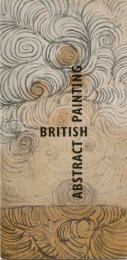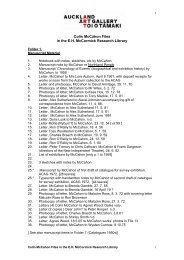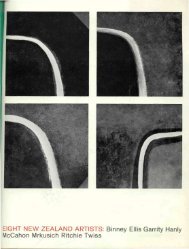The Museum EnvironmentBooklice (Psocoptera: Liposcelidae)—also calleddust lice. These minute insects feed on moulds, paperfibres, glue size and dried insects. Booklice are dependenton a relatively high humidity and are absent fromdry, well ventilated buildings. Although they do very littledamage themselves they provide a warning that conditionsmay be unsatisfactory.Beetles (Coleoptera)—these can be divided into twogroups:Beetles that damage wood, such as the commonhouse borer (Anobium punctatum). These are small,brownish beetles up to 5 mm long and are easily recognisedby their hooded heads. They are active fromNovember to March each year and attack all woods.Their eggs are laid in crevices and old borer-holes,hatching into small grubs in about three weeks. Theywill bore in the timber for three to four years beforeemerging as adults; thus the first signs of borer attackwill be the appearance of holes in the artefact as theadult insects leave to infest other timber.Beetles that cause damage to other materials suchas textiles, furs, fabrics, hides, feathers, dried insects,plants etc, such as the larvae of the carpet beetle(Dermestidae).Termite (Isoptera: Rhinotermitidae)—the NewZealand drywood termite has the potential to infestmuseum objects, attacking the end-grain surfaces ofdamp wood.House-fly (Diptera: Muscidae)—flyspots are acidicand become insoluble over time, leaving permanentstains.Pest ControlKeep Storage and Display Areas Clean—reduce thepest attractants. Food should not be consumed in storageareas and is also not recommended in the displaygalleries as it encourages pests. Regular cleaning of allareas is advisable. Organise or discard clutter. Filters onair-conditioning systems and/or insect screens will preventflying insects entering the area. When new objectsare brought into the building they should not be takendirectly into a storage or display area. They should beinspected in a separate room. If insects or eggs are foundthey should be removed if possible; if not, they will needfurther treatment and a conservator should be contactedfor advice.Protect Individual Objects in Storage from Infestation—objectsmade of vulnerable materials such asfeathers, textiles, furs, etc, should be given extra protectionin storage. Wrapping in acid-free tissue and storagein boxes is an advantage.Regular Inspections of the Collection—these areextremely important to check for any signs of infestation.Insect traps can be used. Collect specimens and place inalcohol or freeze for identification purposes. Isolateinfested objects from other items in the collection.Treatment—residual insecticides such Permigas orCislin (permethrin in aerosol form) can be sprayedaround entranceways and the bases of storage and displayunits, to halt the movement of crawling insects.Insecticides must not be sprayed directly on to objectsthemselves and must be re-applied every 3–4 months.Because they work by killing only insects that crawlacross the sprayed surface, they are reasonably safe touse, although all pest control products should be consideredpotentially harmful to health.Because fumigants are damaging to both humansand the environment, many have been banned or theiruse restricted. Consequently a number of alternativesare being developed that are safe and effective whichinclude freezing, anoxic treatment (using oxygen scavengerssuch as Ageless, or carbon dioxide) and the use ofspecific fumigants in controlled conditions.Please contact a conservator for advice on a suitabletreatment.MouldSome types of mould include:Mildew—is the most common fungus to attack textilesand it appears as small black spots. Mildew allowed6
The Museum Environmentto remain on natural fibres will stain, gradually weakenthe fibres and create holes.Dry Rot—the surfaces of wooden items can bestained by mould, while wood-rotting fungi such as dryrot severely damage the structure. Wood decay such asdry rot and wet rot will only develop where wood is constantlydamp or wet.Mould on Paint—the supports of paintings are susceptibleto fungal attack but mould can also grow on thepaint layers. This usually begins with the mould growingon the support or on surface dust. Either way, iteventually eats into the paint layer as well and can leavepermanent stains.Foxing—the brown spot stains on paper called ‘foxing’require the combination of metallic impurities inthe paper and micro-organisms for their development.Mould ControlKeep Storage and Display Areas Clean—dust containsdormant mould spores and will sustain theirgrowth under favourable conditions.Keep Relative Humidity Below 65%—air conditioningshould operate 24 hours a day. If there is no air conditioning,storage should be in a drier part of thebuilding. Do not store works of art or artefacts in dampbasements. Avoid hanging pictures on outside walls thatare not insulated or on walls that feel cold or damp.Do not frame pictures in direct contact with glazing.If items are stored or displayed in closed or airtightcontainers, the internal relative humidity should be considered.It may be advisable to control it with silica gel.Maintain Good Air Circulation—good air circulationreduces the likelihood of mould growth. Do not storeworks of art or artefacts directly on the floor. Raise themup on supports to permit the air to circulate. Circulationof air behind pictures may be assisted by attaching piecesof cork, rubber, plastic or cardboard to the lower cornersof frames so that they are held away from the walls. Donot store or display items in closed containers or roomswithout provision for air circulation or dehumidification.Regular Inspections of the Collection—regularchecks may mean that a problem is caught before it getstoo bad. Photographic records of condition mean thatany changes can be quickly and accurately identified.Avoid the Use of Fungicides—they should be avoidedif possible as there is a risk of damage both to theobjects and to human health. If there is a mould infestationconsult a conservator for advice.7
















